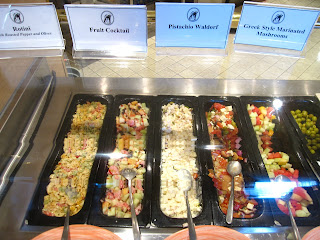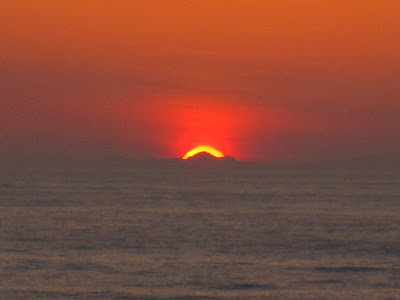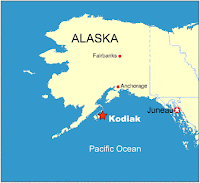
For one week we steamed across the North Pacific, shown here on the touch-screen map in the Ship's Library, averaging about 20 knots. In a normal week the boat spends a few days sitting in a port from maybe 7 am to 5:30 pm, allowing us from 8 to 5 for sightseeing after the boat clears customs and before the crew checks the computer to see that everyone's back on board (they scan your room key each time you get on or off).

Between ports, the ship only goes fast enough, usually 14 to 19 knots, to be at the next port in time for the scheduled disembarkation, since speed is money, with fuel efficiency dropping off quickly over 18 knots. On such a schedule, the
Volendam typically burns about a quarter of a million dollars a week worth of marine diesel moving the ship and powering all the lighting, cooking and other electrical needs. In this week, that rose to a third of a million dollars due to the speed and continuous pace.

As always, our day began with a daily program listing the days' events -- that's it on the coffee table in our stateroom -- and with an 8-page abbreviated edition of the New York Times, which kept us at least minimally aware of the world outside the ship. Canadians, Aussies and Germans could request comparable though briefer editions of papers from their own countries. Breakfast was available in the sit-down restaurant, but in all our 97 days on board, we never once went there, much preferring the cafeteria-style Lido Deck restaurant. With a waffle bar, an omelette bar and a benedict bar (traditional, with spinach, with lox, or 3 other ways), plus a full selection of fresh fruit and all the traditional American standards from fried eggs to oatmeal, we had no complaints.

Similarly, we always had lunch in the Lido unless we were off exploring some port. There were make-your-own sandwich fixings,

a wrap and panini station where they made up and grilled a sandwich to your specifications, and a selection of 6 or so hot entrees.


Of course there was always lots more fresh fruit, salad items, and soups to die for. About three times a week they also set up a remote serving location that rotated between traditional Filipino, Indonesian and Indian cuisine,

though the spiciness was toned down for the wimpy North American or Australian palate of the average customer. For the
truly gastronomically challenged,

there was also a spot next to the midship pool where you could choose between the pizza bar and make-your-own tacos, or order up a cheeseburger or hot dog from the grill.

Between lunches and dinners we had soup well over 100 times,and loved it every time, a different soup almost every meal! This photo is obviously not from our week crossing the North Pacific, but from one of those rare days when we returned to the ship for lunch when it was berthed close to town.

Dinner always had several interesting appetizers as well as those terrific soups, and at least six entrees to choose from. For the most part we had dinner on the Lido Deck, but did go to the sit-down restaurant a little over once a week, particularly at the beginning of a cruise segment (our 67-day cruise was actually 4 segments with all but 180 of us end-to-enders out of 1400 total passengers getting on and off at Singapore, Hong Kong or Kobe). You just showed up at the entrance and got seated with your party, if you came with friends, or at a table with 4 to 8 strangers depending on table size. Several of the couples we became friends with were met this way.

The appetizer, salad and entree selections were the same as on the Lido Deck, but you were served as you would in a restaurant. Click on that menu to read a typical evening's choices (hit your browser's back button to return). About every fifth night was "formal night," and the standards were ones we could meet despite our fairly informal wardrobes.



Twice, once westbound to NZ and once on the way back, we went to the "Master Chef's Dinner," with a fixed menu ending with baked Alaska, but the goofiness -- such as the chef's hat friend Carole is wearing -- was a bit much for us.

And of course there was dessert! Here's a typical dessert menu, with the same available on the Lido Deck with no one counting how many or how often. And if that weren't enough,

there was always a chocolate waiting on your bed at nighttime, along with the latest in "towel art" creatures.


At 10:30 each night, there was also a "midnight buffet," usually rather lightly attended both by us and by the rest of the overfed complement of guests, but once each cruise segment that morphed into a "dessert extravaganza" next to the midship pool, and
that was not to be missed!




You're probably wondering how fat we got after all this, right? We stayed surprisingly close to our pre-boarding weights by being very choosy about what we ate, and by spending all those hyperactive days in port. With a week at sea, it was trickier. There was always the gym, but stationary bikes are not our thing. Then there was the walk around the Promenade Deck, 2½ circuits to the mile,

but it was actually
cold out there, in the forties during the daytime and thirties at night. When we left Aomori we were at 42°, the same as Boston, and we were headed to 59°, the same latitude as Stockholm. So we watched the food intake extra closely, make an extra effort to use stairs instead of elevators, and survived the week.
There is a lot onboard to keep you busy. We were constantly reading ahead in guidebooks -- the ship had a good collection for every place we went to, which you could borrow for a few hours by trading in your room key for the book. We read prodigiously in other genres as well, such as a biography of Vitus Bering during this segment or
Red China Blues just before landing in China, or best-sellers like
The World Is Flat and
Freakonomics from the ship library, or

novels that we picked up along the way, too numerous to name. We'll be happy to suggest book titles if you email or phone us, since at $30-40 a month for books for two years, almost all of those used books, plus a dozen brought from home and borrowed books wherever we could get them, we read a
lot.

As mentioned in a prior blog, we also had lectures each sea day on the history or natural history of an upcoming city or country, plus a talk about each upcoming port and how to maximize our time there.

After sunset, there was always a big show in the main theater, such as this dulcimer player from China, a singer/pianist named Amy Ambler who quite impressed us with her energy as much as her skill, and another singer who looks good and sang well but not enough to leave a dent in our memory for her name.



Several times during the trip, the Filipino and Indonesian crews put on their own shows, which were enthusiastically performed.


The big shows tended to be of one type, so we only went to a few, and walked out on a few when they failed to break the mold despite our best hopes from the daily program write-up.

The string quartet might have been a good alternative, but they need a bit more practice before going to prime time, and by the second week we knew nearly the entire repertoire. Sigh. Anyone who knows us knows that the slots, the piano bar and the smooth dance band were not our style, though we did enjoy observing them with sociological detachment.





So we spent our evenings reading in the ship's library, walking about and enjoying some of the ship's attractive design

such as the dramatic atrium amidships between the 3rd and 5th decks, saying hi to some of our favorite staff such as Cathy at the Front Desk,

or stepping out -- quickly! -- for a look at the moon reflecting off the cold Pacific sea.


We had, for the first time, a cabin on the outside of the ship, but not much to see but the sea. On the third day we crossed the International Date Line, and they had a Swim Back in Time event in the midship pool, but the large ocean swell on the North Pacific made this a more athletic event than the swimmers probably counted on.


This was in fact the roughest patch of water we encountered on either voyage, to or from New Zealand, and an

emesis bag dispenser magically appeared on each floor at each elevator. Louise got to make good use of them, but Jeff and much of the rest of the passenger manifest made it through with just queesiness from time to time. There was a pretty good run on crackers and green apples, the cuisine of choice for those attempting to regain the will to live after a bout of
mal de mer.
And then, the night before we were to land in Kodiak on Kodiak Island, magic occurred. Jeff took a photo of the sunset, then jumped when he looked at it enlarged. We have gone 6 days and 6 nights without seeing land, and there it is, on the horizon, silhouetted by the sun!!!


Almost everyone is bonkers from sleep disorders, as we've been setting the clock ahead every night by an hour, two hours the first night, and our brains are on Tokyo time while here we are in Alaska! But tomorrow we get off the ship, and we are psyched! Kodiak, here we come!

.jpg)



